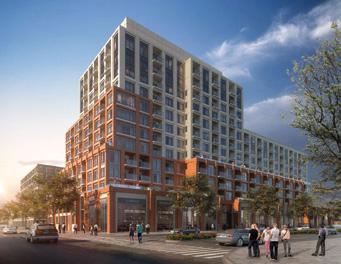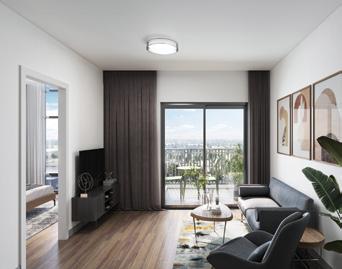




































































































We start with location. We let the land decide what our communities should look like. We create simple yet remarkable amenities to bring families together. That sense of place helps to determine the design and character of each community’s Master Plan.
Ask yourself if what you’re looking for is a place to live – or a place to Live Remarkably.
















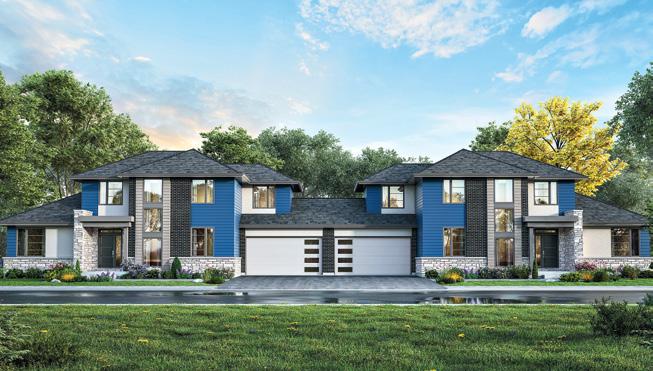



Spring will soon transition into summer, interest rates seem to be stabilizing, inflation is waning and the real estate market is showing signs of that typical seasonal resurgence. Roaring back to life, even.
All good, right?
Sort of. Supply, or more specifically lack of, continues to be an issue. In the resale market, quality and fairly-priced homes in good areas are snapped up in days. In the new home segment, however, government-inspired initiatives to promote more homebuilding will take some time to fully come to fruition.
The 2023 federal and provincial budgets, then, are crucial to doing whatever they can to ensure the housing market remains as healthy as possible in the interim.

According to representatives of the homebuilding industry, the 2023 Ontario budget is expected to help address the housing supply issue facing the province. Entitled Building a Strong Ontario, the budget lays out important measures that will support more housing supply and choice across the province.
EDITOR-IN-CHIEF
Active Life Magazine
EMAIL: wayne.karl@nexthome.ca
TWITTER: @WayneKarl
Says Terri Johns, president of the West End Home Builders’ Association, “The residential construction industry is encouraged by (the) budget, because it means the provincial government recognizes the need to build a strong foundation to construct the 1.5 million homes we need over the next decade, essential to restoring housing attainability in Ontario.”
“Boosting our housing supply is critical to the economic well-being of Ontario, and I was pleased to see that in spite of the strong headwinds we are facing, the government is intent on meeting the 1.5-million target,” adds Richard Lyall, president of the Residential Construction Council of Ontario (RESCON).
The federal budget, on the other hand, seems to come up a little short. RESCON says the budget includes items that will help young people enter the housing market, but it fails to address the problem of how to rapidly increase supply across the country.
“We have a crisis on our hands and need to build more homes quickly and make them affordable,” says Lyall. “The budget is nibbling around the edges of the problem and doesn’t fully address the systemic problems that are delaying construction of much-needed housing. We need to get more housing underway quickly as demand is expected to continue.”
Unfortunately, for something so important to Canadians, new Canadians and the economy overall, it seems to be a tale of two diverging budgets on the housing front.
1. Unusually high energy use.
2. Drafty rooms and uneven temperatures.
3. Cold floors and walls in the winter.
4. Dark spots on walls or ceilings.
5. Ice dams or snow melting on your roof.

Whether you rent or own, you may qualify for free insulation, draft proofing and a smart thermostat based on household income or if you receive assistance from certain government programs.
To keep cool air inside your home, it’s important to identify where air is escaping. A program delivery agent will check door and window frames, electrical outlets and switches, trim and baseboards, attic hatches, fans, vents and more common leak areas to help you seal and save.
Your home heating and cooling system may be working overtime
because there isn’t enough insulation. Checking your basement, attic and exterior walls to see how much insulation exists is essential to find out where more may be needed. A well-insulated home is more comfortable and energy efficient year round.
What happens next if you qualify?
• An authorized program delivery agent will contact you with a few short questions. They’ll ask for proof of income, such as a benefit statement. This will be kept confidential.
• Then they’ll visit your home to check whether it’s properly insulated and to see where air
is escaping. This home energy assessment usually takes about two hours.
• If your home is eligible, professional contractors will install upgrades at your convenience at no cost to you.
• Finally, a delivery agent will make a follow-up visit to make sure everything’s working properly.
To learn more about the program and see if you qualify, visit enbridgegas.com/ winterproofing or apply by phone in minutes at 1-844-770-3148.
Jesse Abrams is Co-Founder at Homewise, a mortgage advisory and brokerage firm based in Toronto. thinkhomewise.com



Mark Cullen is a Member of the Order of Canada, and provides gardening advice to more than two million Canadians each week. Ben Cullen’s specialty is food gardening. markcullen.com; Facebook @MarkCullenGardening and Pinterest @MarkCullenGardening.
Greg Gazin is a syndicated tech columnist, blogger, podcaster, and contributes to canoe.com, Troy Media and Active Life magazine. gadgetguy.ca
Linda Mazur is an award-winning designer and Principal of Linda Mazur Design Group. With almost two decades of experience this in demand multi-disciplinary design firm is known for creating relaxed, stylish spaces and full-scale design builds throughout the GTA and Canada. lindamazurdesign.com @LindaMazurGroup
Agnes Ramsay is a Registered Nurse, Personal Trainer and Wellness Coach who specializes in Electric Muscle Stimulation Training. agnes.ramsay@xbodyworld.com
Lisa Rogers is Executive Vice-President of Design for Dunpar Homes. Lisa has shared her style and design expertise on popular television programs such as Canadian Living TV, House & Home TV and The Shopping Channel. Lisa is also a regular guest expert on CityTV’s Cityline. dunparhomes.com.


Jayson Schwarz LL.M. is a Toronto real estate lawyer and partner in the law firm Schwarz Law Partners LLP. Visit online at schwarzlaw.ca or email info@schwarzlaw.ca with your questions, concerns, critiques and quandaries.

Dave Wilkes is President and CEO of the Building Industry and Land Development Association (BILD), the voice of the homebuilding, land development and professional renovation industry in the GTA. For the latest industry news and new home data, follow BILD on Twitter, @bildgta or visit bildgta.ca.
SENIOR VICE-PRESIDENT, SALES, NEXTHOME
Hope McLarnon
416.708.7987, hope.mclarnon@nexthome.ca
DIRECTOR OF SALES, ONTARIO, NEXTHOME
Natalie Chin
416.881.4288, natalie.chin@nexthome.ca
SENIOR MEDIA CONSULTANTS
Amanda Bell
416.830.2911, amanda.bell@nexthome.ca
Nina Downs
1-888-532-2579, nina.downs@nexthome.ca
EDITORIAL DIRECTOR
Amanda Pereira
EDITOR-IN-CHIEF – GREATER TORONTO AREA
Wayne Karl, wayne.karl@nexthome.ca
GARDEN EDITOR
Mark Cullen
CONTRIBUTORS
Jesse Abrams, Ben and Mark Cullen, Greg Gazin, Linda Mazur, Agnes Ramsay, Lisa Rogers, Jayson Schwarz, Dave Wilkes
EXECUTIVE MEDIA CONSULTANTS
Jacky Hill
Michael Rosset
VICE-PRESIDENT, MARKETING – GTA
Leanne Speers
MANAGER, CLIENT RELATIONS
Sonia Presotto
MANAGER CUSTOMER SALES/SERVICE
Marilyn Watling
SALES & MARKETING CO-ORDINATOR
Gary Chilvers
BUSINESS DEVELOPMENT MANAGER
Josh Rosset
DISTRIBUTION distributionteam@nexthome.ca
ACCOUNTING INQUIRIES accountingteam@nexthome.ca
DIRECTOR OF PRINT MEDIA
Lauren Reid–Sachs
VICE-PRESIDENT, PRODUCTION – GTA
Lisa Kelly
PRODUCTION MANAGER – GTA
Yvonne Poon
GRAPHIC DESIGNER & ASSISTANT MANAGER
Alicesa Pullan
GRAPHIC DESIGNER & PRE-PRESS COORDINATOR
Hannah Yarkony
GRAPHIC DESIGNER
Mike Terentiev
Published by nexthome.ca
Advertising Call 1.866.532.2588 for rates
and information. Fax: 1.888.861.5038
Circulation Highly targeted, free distribution network aimed at real estate buyers using street level boxes, racking and Globe and Mail in-home delivery.
Canadian subscriptions 1 year = 6 issues – $35 (inc. HST). Canada Post – Canadian Publications Mail Sales Product Agreement 40065416.
receive digital editions & newsletters to your inbox!
up
Official Media Partners:
Copyright 2023 All rights reserved. All copyright and other intellectual property rights in the contents hereof are the property of NextHome, and not that of the individual client. The customer has purchased the right of reproduction in NextHome and does not have the right to reproduce the ad or photo in any other place or publication without the previous written consent of NextHome.
Terms Advertisers, Editorial content are not responsible for typographical errors, mistakes or misprints. All prices are correct as of press time.
Editorial Submissions from interested parties will be considered. Please submit to the editor at editorial@nexthome.ca.








The GTA new home market picked up slightly in March, compared to the previous month, the Building Industry and Land Development Association (BILD) reports.

There were 1,277 new home sales in March, which was down 70 per cent from March 2022, and 65 per cent below the 10-year average, according to Altus Group, BILD’s official source for new home market intelligence.
Condominium units, including those in low-, medium- and highrise buildings, stacked townhouses and loft units, accounted for 893 units sold in March, down 73 per cent from March 2022, and 63 per cent below the 10-year average.
There were 384 single-family home sales in March, down 57 per cent from March 2022, and 67 per cent below the 10-year average. Single-family homes include detached, linked and semi-detached houses and townhouses (excluding stacked townhouses).
Total new home remaining inventory was 14,479 units, slightly lower than the previous month, but up substantially from last year’s record low in March. It included 12,887 condominium units and 1,592 single-family homes, representing about 10.5 months and six months of inventory, respectively, based on average sales for the last 12 months. Remaining inventory includes units in preconstruction projects, in projects currently under construction, and in completed buildings. A balanced market has nine to 12 months of inventory.
“Sales of new homes may have been muted for the past few months due to short-term market conditions, but demand will inevitably return as GTA families resume looking for the homes they need,” says Dave Wilkes, BILD president and CEO. “That’s why we commend the provincial government on the further steps it
took recently to address housing supply and affordability – the introduction of Bill 97, the Helping Homebuyers, Protecting Tenants Act, and a consultation about changes to the provincial policy statement, which governs land use planning. Both of these steps will ultimately make it easier to add much-needed new housing supply in Ontario.”
“Overall, the new home market remains poised for an upswing, as inventory levels are robust and pricing crawls higher,” adds Edward Jegg, research manager with Altus Group.
“With interest rates holding fast and the resale market strengthening, buyers have begun to re-emerge from the sidelines.”
The benchmark price for new single-family homes increased in March compared to the previous month, to $1.79 million, down 2.1 per cent over the last 12 months. The benchmark price for new condominium apartments increased in March compared to the previous month, to $1.11 million, which was down 10.8 per cent over the last 12 months.
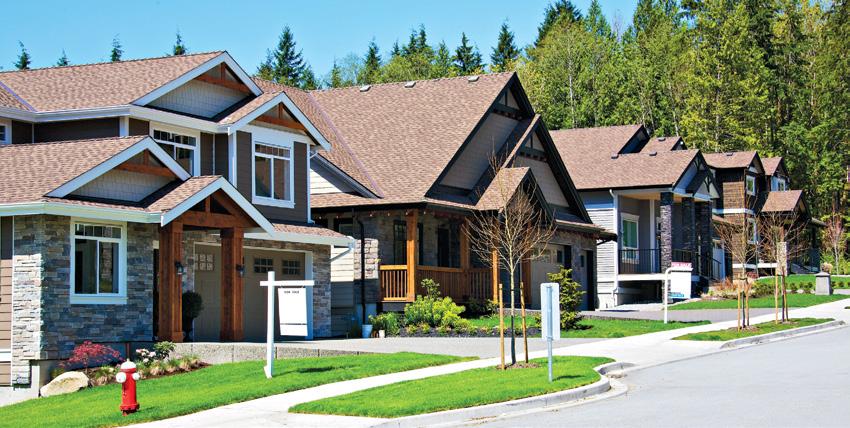
The GTA housing market continued to tighten in April 2023, the Toronto Regional Real Estate Board (TRREB) reports. On a year-over-year basis, sales edged lower compared to April 2022, but new listings were down by more than one-third. Fewer listings relative to sales meant there was more competition between buyers, supporting an improvement in selling prices since the beginning of this year.
“In line with TRREB’s outlook and recent consumer polling results, we are seeing a gradual improvement in sales and average selling price,” says TRREB President Paul Baron. “Many buyers have come to terms with higher borrowing costs and are taking advantage of lower selling prices compared to this time last year. The issue moving forward will not be the demand for ownership housing, but rather the ability to meet this demand with adequate supply. This is a policy issue that requires sustained effort from all levels of government.”
GTA realtors reported 7,531 sales through TRREB’s MLS system in April 2023 – down by 5.2 per cent compared to April 2022. In comparison to March 2023, sales increased on an actual and seasonally adjusted basis. On a year-over-year basis, new listings were down by 38.3 per cent in April 2023.
The MLS Home Price Index (HPI) Composite Benchmark was down by 12.1 per cent year-over-year in April 2023. Compared to March, the benchmark price was up on an actual and seasonally adjusted basis. The average selling price in the GTA was $1.15 million in April 2023 – down 7.8 per cent compared to $1.25 million in April 2022. The average selling price also increased compared to March, both on an actual and seasonally adjusted basis.
“As demand for ownership housing has picked up relative to supply, we are seeing renewed upward pressure on home
prices,” adds TRREB Chief Market Analyst Jason Mercer. “For a short period of time, higher borrowing costs trumped the impact of the constrained housing supply in the GTA. Renewed competition between buyers is once again shining the spotlight on the persistent lack of listings and resulting impact on affordability.”
“Lack of affordability in the GTA ownership and rental housing markets has been well-documented,” says TRREB CEO John DiMichele. “On top of this, households faced with steep price increases for basic goods and services have had to make tough decisions to adapt. It is time for governments to make tough choices as well. On average, every dollar a household makes in the first half of the year goes to taxes. Governments need to provide more value for every tax dollar they collect and should be looking for ways to reduce tax burdens moving forward.”
The City of Hamilton, along with Burlington and Grimsby, find themselves at the centre of a troubling paradox, according to homebuilding industry sources:

1. Metro Hamilton has a preexisting housing shortage and needs to double homebuilding over the next decade to address this shortage and keep up with population growth
2. The shortage of housing in Metro Hamilton has caused home prices and rents to rise higher than in other communities in Canada
3. Metro Hamilton’s high home prices and rents risk pricing out the workers needed to build those homes
Failing to address the housing shortage will not just cause living in Hamilton to become less affordable, but it will also strain the social and economic viability of the community. With an aging population, the region must attract and retain experienced workers to replace those retiring. It will need healthcare workers to care for an aging population and education workers to ensure Hamilton is a viable option for families
with children. A new report entitled “Who Will Swing the Hammer?” from Smart Prosperity Institute with support from the Hamilton Chamber of Commerce and the West End Home Builders’ Association, tackles this problem head on.
“Hamilton’s population is aging. We need to do more to ensure there are enough housing choices for both Millennials and Generation Z. Without that, we won’t have enough workers to support our local economy. Unfortunately, Hamilton is lagging behind communities like KitchenerCambridge-Waterloo when it comes to attracting younger families,” says Jesse Helmer, senior research associate, Smart Prosperity Institute.
“Hamilton’s vision is to be the best community to raise a child and age successfully, and in order to achieve that goal we must urgently address the current housing shortage,” adds Greg Dunnett, president and CEO, Hamilton Chamber of Commerce.
“Hamilton area businesses are looking to attract the best and the brightest talent from around the world, but for people to make Hamilton home, we need enough attainable,
family-friendly housing options so these workers can afford to live in our community. We need to take decisive action today, or we will risk losing talent and opportunities to our neighbouring regions.”
“Hamilton’s housing costs, relative to other cities like Brantford or London, are a primary driver of young families leaving the area,” says Mike Moffatt, senior director, Smart Prosperity Institute. “The high cost of housing is like a payroll tax for Hamilton area employers. If they wish to retain their workforce, there will be significant upward pressure on wages.”
Adds Mike Collins-Williams, CEO of the West End Home Builders’ Association, “Failure to construct enough housing, particularly attainable family-friendly housing, will make it challenging for Hamilton to attract and retain talent. Hamilton already lacks affordability for families; the region cannot allow the problem to worsen, otherwise we will lose the competition for talent. We need to build a lot more homes of all types and tenures for our growing community, it’s time to get shovels in the ground.”
Georgian Communities a new-home builder like no other When you know, you know. And when you research or visit any of Georgian Communities’ properties in southwestern Ontario, you quickly and easily get the sense that this is no ordinary builder.

The ‘Forest City’ gets a boost from the Green economy It’s rather fitting that London, Ont., known as the Forest City for its balance of city and nature, is about to get a serious economic boost from a major Green project in a neighbouring community.

How to make your allwhite kitchen pop with colour

Your new retirement lifestyle awaits at Riverstone Villas in London

Located in the thriving and sustainably focused community of West 5, your new retirement lifestyle awaits at Riverstone Villas.
Colourful kitchens are definitely a trend we are seeing everywhere. Rich deep blues, earthy greens and bold reds are prominent in kitchen design, as are warm-toned woods and even fun-filled pastels. Does this mean that white kitchens have waned in popularity? On the contrary.

The fitness industry is full of the latest “quick fixes.” From vibrating belts, to ab rollers, the Thighmaster to vibration plates. From downright dangerous, to mostly marketing to being legitimate trends.
Why active lifestyle communities are the biggest retirement trend in Canada
Coinciding with the pandemic-era surge in retirements is the increasing demand for senior housing, including active adult or active lifestyle communities. These popular, low-maintenance communities o er a social and friendly environment for those 55 and older and are fast becoming the biggest trend in retirement living in Canada.




Earphones, earbuds or headphones, there’s no shortage of wired or wireless personal devices you can use to listen to your favourite tunes or podcasts on the go. Typically, these would be worn in or over the ear. But this relatively new kid on the block, the Creative Outlier Free Pro uses bone conduction technology and is comfortably worn around your head resting just outside the ear.
While this gadget is new, the concept of hearing through bone conduction is not. In fact, it’s been said the famous composer Ludwig Van Beethoven, who lived more than 200 years ago, despite being deaf conceptually used this type of technology to help him compose his masterpieces, albeit in a slightly different way. He supposedly attached a rod to his piano and clenched it with his teeth.

Technology has come a long way since then.
The Outlier Free Pro is a onepiece wireless lightweight 1.11-oz. headphone made from a titanium memory alloy and silicone. It’s worn comfortably around the head and loops over your ear. It uses transducers at each end instead of ear buds. They rest outside your ear just above your temporal bones to transmit sound vibrations through the bones of your skull directly to your inner ear. In essence, it bypasses your eardrums allowing you to hear what’s being played without anything being physically present in your ear.
This sounds a little unusual, pardon the pun, but it does work. The beauty of this type of set up is that you can listen to music or podcasts and make to take calls while still being able to totally hear what’s going on around you also making it great for safety. It’s also ideal for sports enthusiasts particularly joggers and cyclists out on the open busy streets or while doing workouts and getting in shape while chatting it up with your friends at the gym.

It has an IPX8 waterproof rating, so it’s sweat proof, rain proof and can even be used underwater making it ideal for swimmers. Since you’re not likely to take your phone with you onto the pool, you can listen to your tunes through Outlier Free Pro’s built-in music player. It also features 8GB of storage good for up to 2,000 songs.

Outlier Free Pro frees up your ear, but it does come with a little tradeoff. It’s important to note that bone-conducting headphones may not offer the same audio fidelity and noise isolation as traditional headphones. This can be quite noticeable for example when you’re at a noisy mall. The ambient noise going to your ear is competing with
the sound vibrations going through your cheekbone.
Nevertheless, Outlier Free Pro can certainly be a suitable option for those who want to enjoy audio while still being aware of their surroundings or for individuals with specific hearing needs.

Some ways around the issue are: Increasing the volume, moving the transducers closer to your ears or wearing earplugs which come included in the package designed to be used and work quite well when underwater.

Creative Outlier Free Pro is compatible with iOS, Android mobile devices, as well as PC and Macintosh computers. It also features the latest Bluetooth 5.3, so you can get a
great connection while consuming less power, as well as multipoint connectivity so you can be connected with up to two Bluetooth devices at one time, so you can grab an incoming call while you’re listening to your favourite podcast on another.
There’s also a built-in noise canceling microphone for phone calls and a mini plug inconspicuously attached to the headset to protect your mic when you’re in the water. It has in-line button controls and for added hands-free use, it’s also Siriand Google Assistant-friendly.

It has a respectable battery life, rated at up to 10 hours. It takes about two hours to fully recharge but, in a pinch, you can get up to two more hours with as little as a 10-minute recharge.
Creative Outlier Free Pro is an impressive unique little set of headphones for the right person and the right environment.
Included in the box is a 0.6m proprietary USB-A magnetic clipon charging cable, a pair of silicone earplugs, spare mic plugs and a quick-start guide. It comes in one colour – Midnight Blue and retails in Canada for $179. You can get one directly from Creative Labs (currently $149) or wherever Creative products are sold.
If swimming is not in your routine and you don’t need a built-in music player or built-in storage, Creative also makes the Creative Outlier Free. The non-pro version without these extras has an IPX5 rating making it water resistant against rain, sweat and splashes but not truly waterproof. It comes in Dark Slate and retails for $99. (currently $89).

From Humble beginnings in 1960, Lucchetta Homes has been building beautiful places people love to call home with passion and purpose. And while the company has grown and matured over the years, it is still a family-run business and proud to be one of the top homebuilders in the Niagara Region. It stays true to the principles that have guided it from the beginning: Providing a great customer experience and building desirable communities in prime locations with homes of innovative designs and quality construction.
Design is the cornerstone of the Lucchetta difference. The company doesn’t design for itself, it designs for its customers. That’s why you’ll see the latest trends in home design in all Lucchetta models and floorplans. Every square foot serves a purpose.
Every design feature adds to the function and livability of your home.
The Lucchetta Design Centre Specialists have years of experience, making them another great resource as you choose the finishes and options for your new home. They help you keep both your dreams and your budget in check as you make your design selections. Buying a new home is an exciting step, and it’s just the first of many more before moving day. Lucchetta wants to make sure you know what to expect ahead of time – the timeline, the choices, your responsibilities and the company’s. There’s a standard building code, and then there’s Lucchetta. “We only want to build homes that we’d want to live in ourselves,” the company says. “We created better building standards of our own to do it.”
From the very beginning, it’s been their goal to build a better home with the features and benefits that give you confidence and lasting value. From foundation to rooftop, from wall to wall, Lucchetta is constantly striving to give homeowners the very best in solid, sound, energy efficient living. For almost 60 years, homeowners have counted on Lucchetta Homes for quality, integrity, trust and care. You can, too.
Lucchetta’s methods result in a weather-tight, energy-efficient Energy Star-rated home. You can save as much as 20 per cent on your energy bills, compared to a home built to standard code. Want the home of tomorrow today? Lucchetta Homes is a leader in future housing technology, and one of only two qualified builders in Niagara able
to offer Net Zero construction. A Net Zero home offers the lowest energy costs and comfortable living environment available.

Quality homes were always a given. The principals of the company, Robert and Edward Lucchetta, want you to “Live Your Best Life” and care about quality, about design, about community, and about their customers. Lucchetta’s homes are designed for real life, and how well they work for customers is the real test of their success. A home is more than bricks and mortar – more than lumber, drywall and cabinets. A home is a very special place where your life unfolds and memories are made. Why settle for less? You deserve a home you love. You deserve a home that’s been built to last with unmistakable quality and thoughtful design and built by a builder that truly cares.
Located in the heart of St. Catharines, Lusso Urban Towns boasts a contemporary collection of urban townhomes with access to the best that Niagara has to offer – including abundant local shopping and dining,

sports facilities, schools close by, scenic parks for hiking adventures, challenging golf courses, as well as easy highway access to both Toronto and Buffalo international airports. Choose from a variety of two-storey, one-of-a-kind townhome designs, ranging from 1,817 up to more than 2,200 sq. ft.
Designed with an urban flair, these stylish and spacious two-storey towns reflect a modern, city-feel exterior, yet are built with an optimal layout. Form meets function with these homes from award-winning Lucchetta Homes, featuring two levels of spacious living, nine-ft. ceilings, extralarge single- and two-car garages, beautifully designed kitchens, extralarge windows, stunning exteriors, eight-ft. sliding glass doors leading to a tranquil covered outdoor deck and so much more.
The unique floorplans have three bedrooms located in the upper level, luxurious quartz countertops in the baths and kitchen, over-sized tile flooring, a gas fireplace and spa-like glass and tile walk-in showers in the primary ensuite bath are included in very home at Lusso. Homes in this community are low maintenance, as snow removal and lawn mowing ser-vices are provided by the homeowner’s association for a small monthly fee.
Another Lucchetta community is the award-winning and highly successful The Residences at Hunter’s Point. This is an active adult lifestyle commu-nity, located in a truly unique setting along the Welland Canal in the heart of the Niagara Region. This location offers easy highway access to both Toronto and Buffalo international airports. You can choose any one of several stunning detached bungalows or bungalow townhome floorplans, ranging in size from 1,405 to 1,734 sq. ft.
Overlooking the Canal, residents can relax and watch ships meander slowly towards their destination. With its landscape dotted by wineries, world renowned Niagara Falls, casinos, spas, marinas, spectacular dining, golf courses and trails for walking or cycling, Hunters Pointe is the perfect destination for those seeking to live life to the fullest, without compromising the conveniences of modern living.
Rich with activities and amenities, Hunters Pointe is ideal for independent adults who value a vibrant social and physical lifestyle. Open concept bungalows are loaded with Lucchetta Homes’ architectural elements, upgraded finishes, oversized windows and striking design features.

Welcome to Saffron Estates, the newest master-planned community coming soon to one of Niagara’s most beloved towns, Fonthill. Lucchetta Homes is proud to be
offering a collection of elegant, transitional and contemporary style bungalow homes, perfect for today’s family. Saffron Estates provides residents with a smalltown feeling, where countless parks, trails, greenspaces, walkable neighborhoods, dining, shopping, golf, schools and more are all within proximity. Located minutes from Hwy. 406, the QEW and bustling Niagara Falls, you will find your perfect next home right here in Niagara.
For more information, visit lucchettahomes.com. The company also in-vites you to come by the Lusso Sales Centre at 24 Grapeview Dr. in St. Catharines. The Riverside at Hunters Pointe Sales Centre is located at 1 Perth Trail in Welland. And with construction well underway, Lucchetta also has move-in-ready homes at both sites, so buyer ready to act won’t be disappointed. Call 416.605.3885 or 905.658.2699 and take your first steps toward making your next home a Lucchetta home.
Ah summer… Images of long days, lounging under a tree reading your favourite book, chatting with friends over a spritzer, barbecuing burgers and enjoying endless evenings.
What is your image of the perfect time spent in the summer?
The temptation of relaxation and socializing with its inherent fun food and drinks is certainly part of our love of summer months.
And it is absolutely important that you enjoy these moments in life.
At the same time, don’t forget that our health and fitness should not be put on the back burner. Nothing replaces feeling good, and once good health deteriorates, it becomes more difficult as we age, to get that back.
The great news is that research tells us that it doesn’t take summiting mountains to have good health. But do you need to walk 10,000 steps every day to get any health benefits?

A recent study published in the Journal of the American Medical Association asked the question “What are the associations between daily step counts and step intensity with mortality among U.S. adults?”
According to this large study, yes, more steps can, in essence, equal a longer life with less risk of disease.
However, what was interesting is that 8,000 steps a day was the threshold for change, and it didn’t seem to matter what the intensity level of the steps was, nor did it take into account if the steps were
walking, gardening, housecleaning or what have you.
Please be aware that several other studies, including from the Centres for Disease Control, recommends 75 total minutes of intense exercise per week. However, you can break it up into smaller segments.
To summarize. Move your body – every day. Get your heart rate up at multiple times through the week during your activities. In other words, push yourself without overdoing it. You should always be able to talk during exertion.
Also, importantly – exercise responsibly. Always confer with your doctor before trying something new. During hot summer days, go early or later in the cooler parts of the day. Hydrate, lots of plain water. Wear sunscreen, hats, long light UV shirts and pants. If you go in the forest, wear long pants and socks and look for ticks afterwards.
1) Meet your friends and family for an activity, hike a trail, go berry picking, bike one of the many rail trails. Or simply walk around the neighbourhood and enjoy the gardens.
2) Start playing pickleball. As this sport grows in popularity, it will be easy to find a court/association
near you. Start slow, with a beginners group. And do some research on exercises that you can do to prepare.
3) Rent a cottage that has activities close by. Swimming, hiking, room for bocce ball or croquet with the kids and/or grandkids is always a good laugh.
4) If you are inclined as I am, pick a defined walking route and time yourself. Listen to good music (watch out for traffic) and change your cadence while you are walking. Move quickly and get that heart going, and then slow down until your breathing is normal again, and repeat.
Get outside, preferably in the shade, every day. No excuses. They make rain coats and umbrellas for a reason. Take deep breathes and stop and smell the roses. It is a beautiful world, take it in.
Agnes Ramsay is a Registered Nurse, Personal Trainer and Wellness Coach who specializes in Electric Muscle Stimulation Training. agnes.ramsay@xbodyworld.com
Niagara Region often inspires thoughts of mostly the Falls themselves, those natural wonders to which a visit never grows old.
But beyond the awe-inspiring beauty and power of the Falls and the Niagara River, Niagara Region offers a lot more that’s worthy of just a weekend getaway.

Encompassing towns such as Grimsby, Lincoln, Niagara-onthe- Lake, St. Catharines, Thorold
and Welland, the Niagara Region is blessed with a great natural location.
It occupies most of the Niagara Peninsula, bounded by the U.S. to the south and on the north by Lake Ontario, and of course the Niagara Escarpment – all of which offers strong potential for business and lifestyle choices.
These natural landscapes and climate make the Niagara Region perfect for agri-businesses such
as winemaking – a key economic sector. The Niagara Wine Route, for example, connects dozens of wineries and is a growing tourism draw, complementing cultural events such as the Shaw Festival.
Indeed, a visit to the area can involve a stop at the Falls, winery tours, the quaint town of Niagaraon-the-Lake, the Botanical Gardens, with its Floral Clock and Butterfly Conservatory, several championship
golf courses and a growing casino industry in downtown Niagara Falls.
But this is all for play. To live and work in the region is another matter.
Again, a blessing of location, Niagara is within 800 km of two provinces, nine states and 130 million people on both sides of the border. This means opportunities for business. The trade that flows across Niagara’s borders totals more than $100 billion annually, and supports hundreds of thousands of jobs across Canada and the U.S. The infrastructure network to support this trade activity comprises five international bridges, multiple railways and the Welland Canal, linking Lake Erie into the St. Lawrence Seaway system.
All of this is conducive to growth potential for the region’s manufacturing and transportation and logistics sectors, to complement the historical strength in agriculture and tourism.
Niagara’s economy has shown steady growth in a number of areas, particularly in job creation and new investment, but still
lags slightly behind Ontario averages. The Niagara economic development department confirms the area still has challenges in higher unemployment, lower participation rate and lower household income per capita.
As the economy grows and affords people more opportunity to live and work in Niagara – or close by – new-home development is following.
Much of the housing growth is in the lowrise category, as buyers from the GTA find the lot sizes and price points far more appealing and affordable.
But that, too, is changing, as some consumers prefer the condo lifestyle, even in a nature-rich area such as Niagara. Developers are responding in kind, with several new condo projects, many of them midrise or boutique condominiums.
Silvergate Homes, for example, is launching a new condominium, Merritton Mills on Hastings, near Glendale, in St. Catharines’ popular Merritton area.
A regional municipality in Southern Ontario comprising 12 municipalities such as Grimsby, Lincoln, Niagara-on-the-Lake, St. Catharines, Thorold and Welland; 130 kms from Toronto; 86 kms from Hamilton.
KEY LANDMARKS
• Botanical Gardens
• Casino Niagara
• Clifton Hill
• Fallsview Casino
• Legends on the Niagara Golf Course
• Lundy’s Lane
• Niagara Falls

• Niagara Wine Route

• Skylon Tower
• Welland Canal
• Whirlpool Golf Course
SELECT HOUSING DEVELOPMENTS
CENTURY CONDOS
By Homes by DeSantis centurycondos.caHARBOURTOWN VILLAGE
By Silvergate Homes silvergatehomes.comLEGENDS ON THE GREEN
By Silvergate Homes silvergatehomes.comLUNA
By Silvergate Homes silvergatehomes.comLUSSO URBAN TOWNS
By Lucchetta Homes lucchettahomes.comMERRITTON MILLS
By Silvergate Homes silvergatehomes.comON THE RIDGE
By Homes by DeSantis centurycondos.caONE FONTHILL CONDOMINIUMS
By Mountainview Homes mountainview.comRIVERSIDE AT HUNTERS POINTE
By Lucchetta Homes lucchettahomes.comSAFFRON ESTATES
By Lucchetta Homes lucchettahomes.comSHELTER COVE
By Shelter Cove sheltercove.caTHE OAKS AT SIX MILE CREEK By
Blythwood Homes blythwoodhomes.caVILLAGE ON THE TWELVE
By Silvergate Homes silvergatehomes.comWith its long-standing roots in the neighbourhood, Merritton is rapidly becoming a highly desirable place to live. Its proximity to South St. Catharines and its many amenities makes it ideal for families, singles and retirees. It is also conveniently located close to the Pen Centre, downtown core, hiking and biking trails, Brock University and Niagara College.
In the first phase of Merritton Mills, Silvergate will build a 71-suite midrise condominium, comprising one- and two-bedroom suites ranging from 800 to 1,200 sq. ft.
And Lucchetta Homes is offering Lusso Urban Towns, a hip new community in the heart of St. Catharines. Featuring luxury twostorey urban townhomes, Lusso is located close to major highways, as well as the downtown core, schools, shopping, restaurants, parks and entertainment.
Homes by DeSantis, in another example, is building Century Condos, a four-storey, 87-unit luxury offering in downtown Grimsby with suites ranging from 490 to 1,230 sq. ft. – so named to mark the 100th anniversary of the town.

Part of the appeal for homebuyers in Niagara – besides lifestyle and proximity to some of Ontario’s great natural attractions – is affordability relative to other parts of the Greater Toronto and Hamilton Area
“An idyllic combination of lower home prices and stable mortgage
interest rates is giving sidelined buyers the boost in confidence they need to re-enter the housing market this spring,” says Brad Johnstone, broker of record, Royal LePage NRC Realty. “After a slow start to the year, activity quickly picked up in mid-March. Homes that were sitting on the market started to move into the hands of buyers, while multiple-offer scenarios became more frequent. Although housing inventory remains historically low, we have seen a moderate uptick in the amount of new product coming online in recent weeks.”
With prices down year-over-year and on a quarterly basis, Johnstone notes that buyers are looking for deals in all segments of the market, especially purchasers from other parts of Ontario who are attracted to the comparatively lower prices of the Niagara-St. Catharines region.
“Between interest rates stabilizing, the rate of inflation coming down and increasing levels of demand from both new immigrants and buyers within the province, we are on track for a robust spring market,” says Johnstone. “However, the big question is whether supply levels will increase. My hope is that available units will steadily increase. If inventory doesn’t continue to grow throughout the second quarter, we can expect upward pressure on home prices.”











Got a slope in the sun? Plant sedums or sempervivums.
Got a hot spot where nothing seems to grow? Plant sedums or sempervivums.
Enjoy lengthy times away each summer – looking for the ultimate low maintenance plant?
Plant and forget insect and disease problems? You’ve got it – plant sedums or sempervivums.
If there is a difficult job to do in the sunny garden, you can count on
one family of plants to pull through. Do you remember the “hens and chicks” that your grandmother had in her rock garden? Those were sempervivums (closely related to sedum) and chances are, if the garden still exists, so do the hens and chicks.

The secret to their long-term survival rate is their ability to store water in their leaves for long periods of time. They are the camels and dromedaries of the plant world, and they are fabulous garden plants.
The meaning of “sempervivum” is “always living,” but unlike many other plants that you could say this about, such as common mint, for example, these plants seldom make a nuisance of themselves by spreading where
they are not wanted. And if they do, it does not take much effort with a sharp hoe to flip them out of the soil and into the compost.
The same shallow roots that make them easy to move around the yard also make them easy to propagate and adaptable to poor (gravelly) soil conditions. That is why they have been popular for use in rock gardens for generations. For that matter, few plants do as well planting in the shallow recesses of rockery stone as these succulents.
The most aggressive sedums are the “spurium” types, such as Dragon’s Blood and TriColor. They spread
quickly once established and flower beautifully early to midsummer. Dragon’s Blood produces a shockingly red carpet of flowers that turns heads while TriColor is best known for the three colours of its leaves. Spurium sedums only grow to 10 cm high at maturity, so they lend themselves well to a steep slope where erosion control is desired.
For a fast groundcover space each plant about 20 to 25 cm apart, depending on the size of the plants that you are starting with. They spread horizontally quickly, knitting into a consistent carpet after one or two seasons.
The standard “Stonecrop” that most of us think of is “spectabile.” It grows to about 45 to 60 cm tall, and if you
ignore it for a whole summer, it will reward you with flowers in September through October in the red/pink/rose end of the spectrum. Butterflies and honeybees are known to frequent sedum spectabile. Leave large flowering sedum standing over the winter to allow songbirds to feed on the seeds of the finished flowers.
This is the perfect time of year to dig and divide established sedums and the smaller lower growing sempervivums. Use a sharp spade or shovel to gently remove the mother plant from the soil and then not-so-gently cut them into halves and quarters using the same spade, shovel or a kitchen knife. Replant these smaller divisions around your yard, or give them to neighbours if you have run out of room.
If there is one thing that hardy succulents do not like, other than shade, it is too much water. After planting, you will have to water them, yes. But as time passes, you will have to learn to ignore your sedums and sempervivums. Find something else to do, such as read a good book or spend more time with the weekend paper. Remind yourself why you planted them in the first place: To reduce the maintenance around your garden.
There are a lot of benefits to growing the humble sedum and sempervivums. If you are blessed with some sunny and hot spots in your garden, you could not go wrong by planting a few.


Mark Cullen is a Member of the Order of Canada. He reaches more than two million Canadians with his gardening/ environment messages every week. Receive his free monthly newsletter at markcullen.com. Ben Cullen is a professional gardener with a keen interest in food gardening and the environment. You can follow both Mark and Ben on Twitter @MarkCullen4, Facebook @MarkCullenGardening and Pinterest @MarkCullenGardening.


Located in St. Catharines’ Merritton neighbourhood, Silvergate’s new condominium, Merritton Mills on Hastings, near Glendale, is an opportunity to get in on the changing face of an upand-coming community.
Merritton, with its long-standing roots in the neighbourhood, is rapidly becoming a highly desirable place to live. Its proximity to South St. Catharines and its many amenities, make it ideal for families, as well as singles and retirees. It also provides a smart investment opportunity
due to its proximity to the Pen Centre, downtown core, hiking and biking trails, Brock University and Niagara College.
In the first phase of this exciting new community, Silvergate will build a 71-suite midrise condominium, comprised of one- and two-bedroom suites. Suites are larger than the average, in a range of 800 to 1,200 sq. ft. The Residences of Merritton Mills is designed by Jason Pizzicarola Design Architects Inc. with interior design by BE Burgess and Leslie Landolt Designs. Merritton Mills ticks
all the boxes of modern living. Its location in Merritton is exceptional. It’s a short walk to neighbourhood restaurants and shops, a quick drive
“
”
... Merritton remains a distinctive community within the larger city of St. Catharines.
to Hwy. 406 and the Pen Centre and easily accessible by transit.
The condominium offers a roster of building amenities that include underground parking, storage lockers, co-working space, a common area/lounge, a rooftop lounge with barbecues, a pet washing station, fitness centre, party room with kitchenette, bike storage and parcel room.
Merritton is a small hamlet that became incorporated into St. Catharines in 1961. It has always been a very distinctive community; with a proud history of mills and industrial prosperity and an important role in establishing the early iteration of the Welland Canal.
Today, the former mills, with their heritage bones, mostly operate as hospitality places, but Merritton remains a distinctive community within the larger city of St. Catharines. Located just minutes to the Pen
Centre and less than half an hour from Niagara, Merritton offers its own brand of charm. Contributing to its evolution, The Residences of Merritton Mills is destined to appeal to people who enjoy living near elements of the past as they set about living their best life.
Surrounded by wineries, the lures of Niagara, the conveniences of the Pen Centre just a few minutes away, and all the urban amenities of St. Catharines, Merritton Mills offers the ideal location for people seeking a contemporary condominium in a walkable, shoppable neighbourhood.


Like St. Catharines, which evolved to become a place of hip cafes and restaurants, Merritton is gracefully and gently transforming into a place to live a uniquely urban experience.
Developed by Silvergate Homes, Merritton Mills reflects the carefully nurtured reputation for exceptional quality and a commitment to customer service embodied by Silvergate. For more than 35 years, the Passero family has been building and renovating homes in the Niagara region and beyond. Founders of Silvergate Homes, Vito and Victoria Passero, along with their three children all share the same passion and pride for the family business.
Silvergate Homes is a winner of more than 40 builder awards for excellence, design, marketing and environmental stewardship. The company is a Tarion Warranty Corp. builder and RenoMark contractor. This past April, Silvergate Homes was awarded the Niagara Home Builders’ Association (NHBA) Award of Excellence for the Most Outstanding Condo/Townhome up to 1,500 sq. ft. for Village on the Twelve, nicknamed Eclectic Dream.
Merritton Mills is scheduled to open for sales this summer, operating out of a Presentation Centre on site at Merritt Street (off Glendale). Interested parties are encouraged to register their interest to receive information and updates.
As one of the most reputable land developers and builders in the Simcoe and Grey County Regions, Georgian Communities deliberately establishes neighbourhoods that are purposeful and meaningful. The company’s award-winning real estate projects have created quite the buzz – a passion for nature and community have influenced its vision for three, current unique neighbourhoods and expanding to brand new upcoming communities, as it continually invests in the future of southern Ontario and its rich culture.
Neighbourhoods in small-town Canada hold unique bonds within their communities. Your neighbours become friends, and friends become family. Georgian Communities strives to elevate this sense of togetherness to its highest potential by creating

master-planned communities that focus on bringing people together. Amenities inspired by nature and the surrounding landscapes have a special place in these communities, creating a place for adventure, dreams and simplistic values. Each of Georgian’s thoughtfully designed communities starts with a beautiful Canadian landscape, and is carefully nurtured until it becomes something truly remarkable.
The beauty in simplicity is the core of every one of Georgian’s communities. Everything comes back to nature, and the intrinsic value in a more simplistic lifestyle. From planning and construction to purchasing and decor selections, Georgian works hard to keep things simple, thoughtful and reliable. The company works with local trades to

build its communities. Volunteers for community initiatives. Sponsors sports leagues. By deliberately investing in neighbourhoods to foster meaningful life, Georgian invests in the future of the land and the families that will live there. This is what sets Georgian apart, making it one of the most trusted developers in Ontario.
Connecting people to the land, and to each other, is what Georgian does. They celebrate the rich, fertile soil across Canada and the deep roots of tending the land, and offer homeowners a chance to experience this organic, meaningful lifestyle. After all, how many communities have a sugar shack just around the corner? Or a berry patch just for you? How about a vibrant gathering place known as “The Shed”? Georgian Communities, through the parent company of Georgian International, cultivates the history of its communities, and turns it into something new, inspired, meaningful and unique.
From the classic homes of Windfall and chic chalets of Mountain House to the charming farmhouse inspired homes of Braestone, each of Georgian’s communities reflect their surroundings. The story of Windfall brought to life the Georgian Bay cottage reimagined in a close-knit community true to the history of The Blue Mountains in a many-chaptered book that has become well loved by homeowners as it grew. The newest chapter at Windfall, Mountain House, added a new twist to the region with its chalet-inspired condos and spa-style amenities. Though Mountain House is complete, the story of Windfall continues, with new
opportunities to join the community. Braestone moves away from the mountains and into the classic setting of Oro-Medonte, where rolling fields and gentle woodlands seem painted right out of a storybook. Nestled among this picturesque location is a community of timeless farmhouse estates, with a series of amenities unbelievable in their scope, all focused on wellness, togetherness and nature.
Keeping in line with its communities, Georgian Communities puts thought and care into each of their hospitality amenities. Braestone Club, for example, is an extension of the Braestone brand in Oro-Medonte. Braestone Club is a welcoming 18hole golf club inspired by the rolling hills and glorious sunsets that grace the region, creating a course so in tune with its surroundings that it becomes a timeless part of the land. With its farmhouse-styled Clubhouse and the “Ktchn” restaurant, Braestone Club upholds the values of nature, community and wellness that one expects from the Braestone branding.

By cultivating this brand across Oro-Medonte, a clear image has been made of Georgian International, its values and passion. Braestone started with a farm. As the backbones of


our country, farms cultivate life. As homes sprouted from the rich earth, homeowners drawn to the idyllic lifestyle that Braestone’s remarkable amenities offer, this community grew into something bigger. Classic farmhouse architecture returning to the roots of the region. A golf club, where sunny mornings on the green are surrounded by the whispers of the wind in the trees as the sun breaks the horizon. Food comes from the earth straight to your table, the stars shine brightly overhead at night –best viewed from Starfall, the hilltop observatory of Braestone – and every day brings a new adventure in the rolling fields and winding trails. All of this can be followed back to Georgian Communities and its passion for creating meaningful lifestyles across Ontario, growing into something greater than the sum of their parts.
The uniquely meaningful communities that Georgian creates is something you’ll never find elsewhere. Nature-inspired amenities such as an apiary are not likely to be found in a city. Wellness is an afterthought to many developers, and small-town Canada seems like a thing of the past to those who don’t dream of shady woodlands and friendly neighbours. Georgian Communities knows that small-town Canada holds the secret to life – the way it is meant to be lived. Urban communities have their appeal but will never have the charm and inspiration that lives up at Blue Mountain, or within Oro-Medonte.
For more information, including a new community coming soon to the village of Craighurst, visit georgiancommunities.ca.

In today’s economy, it’s a natural instinct for people to seek additional sources of income. For some, this may include buying an investment property. Not only is purchasing a second property a monumental step toward achieving your financial goals and generating additional income, but it’s also a big responsibility that comes with a lot of considerations. It’s important for buyers to ensure they’re educated and ready to move forward with the purchase – especially if they hope for it to be a long-term investment opportunity.
Here are a few pointers to keep in mind:
What many buyers don’t necessarily know is that there are several different real estate investment strategies. From fix-and-flip to buy-and-hold to wholesaling, it’s important to educate yourself on the options available to ensure you’re making an investment decision that aligns with your goals.
For example, a fix-and-flip strategy involves buying with the intention to renovate and resell quickly for a profit. If your goal is to make money at a faster pace, this could be the option for you. On the other hand, a buy-and-hold strategy involves keeping the property in your portfolio long-term, and renting it out over time. Ultimately, the choice you make is all dependent on the type of property you’re looking to buy and the timeframe in which you want to benefit from the investment.
Therefore, getting clear on these elements should be your very first step.
Purchasing an investment property is different than buying your first home. Although the intent is to gain additional income, an investment property actually adds to your financial obligations in the beginning. Buyers should keep in mind that they will be required to make a minimum down payment of 20 per cent, and carry the mortgage of the property until they find a qualified renter. You also want to factor closing costs and other expenses into the budget – as well as any repairs and ongoing maintenance.
Not to mention, if you still have a mortgage on your primary home, you’ll need to budget for expenses there, too. In some cases, buyers may be able to use their home as a potential financing source to borrow up to 80 per cent of their current home value to help pay for the investment property. It’s best to speak with a qualified mortgage specialist such as those at Homewise, who can walk you through the process and educate you on all of your options.
It’s easy to get lost in the excitement of buying an investment property and generating an additional source of income. However, buyers need to remember that it also comes with more responsibility and commitment. If you’re buying a rental property, you’ll be required to find qualified tenants and maintain the upkeep of the home – as well as any repairs or
potential damages that arise. Even if your goal is to fix and flip a home, you’ll still have added responsibilities on your hands, such as balancing budgets, overseeing contractors and managing trade schedules. No one said it was easy, but if you’re prepared, it’s worth it.
Get in touch with a professional real estate agent and mortgage specialist who can walk you through the steps of buying an investment property and securing the best financing option. The process may be slightly different than when you purchased your first home, which is why it’s important to be informed on all of the key details before moving forward. Be sure to work with a real estate agent who is knowledgeable and can help you find a property in the right location, at the right price. For example, the Homewise real estate team often advises buyers that in order to attract high-quality tenants, you must focus on neighborhoods with nearby schools, hospitals, public transportations and a thriving retail environment.
Buying an investment property is without a doubt a great opportunity that comes with favourable returns. However, it’s crucial for buyers to understand what it takes and what’s involved before making any big financial decisions.

PINNACLE + MEDIUM KITCHEN

Designers: Erica Sibley + Beverley Binns
Binns Kitchen + Bath Design binns.ca
PEOPLE’S CHOICE
Designers: Yao Butterfly + Kerry Anderson Cato
Homey Kitchen Cabinet Design homeykitchencabinet.com
BEST “BEFORE AND AFTER”
KITCHEN
Designer: Erica Sibley Binns Kitchen + Bath Design binns.ca
BEST “BEFORE AND AFTER” BATH
Designer: Frankie Castro Square Footage squarefootageinc.com
BEST TRADITIONAL KITCHEN
Designer: Lyndsie Brandt Otley Design Company otleydesign.com
BUDGET FRIENDLY KITCHEN

Designer: Erica Sibley Binns Kitchen + Bath Design binns.ca
CONCEPT KITCHEN
Designers: Ligia Deltrejo + Holly Cowieson Designström designstrom.com
LARGE KITCHEN
Designer: Benjamin Ouellette Bjoid Interior Design bjoid.com
SMALL KITCHEN
Designer: Erica Sibley Binns Kitchen + Bath Design binns.ca
The NKBA is the premiere association educating and certifying Kitchen and Bath Professionals. For more information visit nkba.org

COMPACT KITCHEN
Designer: Viktoriya Velma Allure Interiors allureinteriors.ca

LARGE BATHROOM
Designer: Lyndsie Brandt Otley Design Company otleydesign.com
SMALL BATHROOM
Designer: Benjamin Ouellette Bjoid Interior Design bjoid.com

POWDER ROOM
Designer: Kate Davidson Kate and Co Design kateandcodesign.com
OTHER ROOM
Designer: Laura Goard Square Footage squarefootageinc.com
MEDIA SPONSOR
CONGRATS TO THE PEOPLE’S CHOICE WINNER OF THE PORTABLECOYOTE GRILL MARINA KENNEDY
 JAYSON SCHWARZ, LLM
JAYSON SCHWARZ, LLM
Let’s explore a scenario: A number of years ago you took advantage of a great opportunity and purchased real estate at a great price. Today, with increasing rents and market growth, your equity value has increased tremendously.
At that time, you moved quickly and everything is in your name or you put it into a holding company, or worse still, you used your operating business to purchase. Now at 55 years of age or older, you are thinking about the future. What if something happens to you? What if you wanted to leave the real estate to your children or grandchildren?
It’s a lot to consider. In Canada, there is a deemed disposition on death, and unless you have a spouse (this delays things until their death), there will be a deemed capital gain on the difference between the adjusted cost base (purchase price plus money put in) and current value. This means the kids will need to find the funds to pay the tax, and may be forced to sell the asset to deal with the tax. This is an unfortunate end when your wishes were to keep the property and have it generate money for the family.
What if it’s in a holding company where you own the shares? Same result on the share value, and worse because it can lead to double taxation. There is a deemed disposition of the shares of Holdco on death, however, Holdco does not have a deemed disposition of
the assets in it. You might end up having to plan and mitigate the tax through proper estate planning (such as pipeline planning, loss carry-back planning and life insurance).
The big question is: What to do? Can it all be reorganized to provide the most tax effective and protective result? The answer is yes. It will not be as perfect as doing it properly the first time, but you can certainly limit your exposure on all fronts.
The interesting piece is that for those who are looking to invest, a lot of the same principles will apply to save you grief later.
The first thing you need to do is speak to your accountant and find out if they have a knowledgeable tax department capable of sophisticated tax planning, and the same applies to your lawyer. If your accountants have these services, find out why they have not discussed this with you before being prompted. Your trusted professionals should be proactive.
Here’s an example that will give you an idea of what can be done with the right support.
Patrick is 55 years old and married to Sherri, with three children all over 18 years of age. When he was 30, he purchased, in his own name, a plaza in Richmond Hill. For the last 25 years, he has been paying down the mortgage and increasing the rent he charges tenants. The building has been well maintained and has increased in value by $4 million. He worries what will happen in the event of his death, and has sought professional help to reorganize his affairs.
The first thing that will happen is that there should be a thorough review of all of Patrick’s affairs, and then a plan will evolve. This might include
using Section 85 of the Income Tax Act to transfer Patrick’s Plaza to a holding company (“Holdco”) on a tax-free basis. In that scenario, when the dust settles, Patrick would own a special kind of share in Holdco that has a frozen value, and perhaps a family trust would own the common shares. What this does in its most simple form, it allows Holdco to redeem a percentage of Patrick’s special shares annually. The more that are redeemed, the less tax will be payable on Patrick’s death. In the meantime, the future gain is accruing to the benefit of the trust and its beneficiaries.
As noted above, contemporaneously with the “freeze,” you might consider that a discretionary family trust be established with Patrick and Sherri as trustees, with both of them, all the children, future descendants and certain corporations, as discretionary beneficiaries.
Tax and succession planning for real estate investments requires integrating professionals who are knowledgeable and capable of providing practical advice tailored to the situation. It’s better to start properly, in order that you will save money in the future. Planning is everything.
 by LISA ROGERS
by LISA ROGERS
Doing our part to help the environment is more critical than ever, so how can we reduce, reuse and recycle our way to more sustainable interior design? It’s easier than you think.



In principle, sustainable design aims to reduce negative environmental impact through thoughtful design.



This means buying more energyefficient products, reducing waste and using limited resources throughout their life cycle. It’s considered one of the fastest-growing segments in the design industry – often referred to as Green interior design – and it encourages more of us to create a sustainable space that helps save our environment. It can sound overwhelming when we think about saving the planet with our actions, but there are things we can do to achieve (better) sustainable interior design.
Energy consumption is a significant contributor to climate change. There is plenty we can do in our own homes to improve energy efficiency by looking at the amount of energy we need for heating, lighting, and running our appliances. Since most
heat escapes through windows, your installed windows must be high quality and provide good insulation. Window coverings also keep both cold air and the sun’s heat outside. Installing home automation (often called Green gadgets) makes it possible to control heat and lighting systems remotely – this will help you use your home’s energy more efficiently and economically. Think about intelligent bulbs, the Nest Learning Thermostat, or Green apps that you can download on your phone and help monitor your energy use.
To save on energy spent on lighting, plenty can be done in picking the right colours. Lighter colours reflect more light while darker walls (and furnishings) do the opposite and require more artificial lighting to
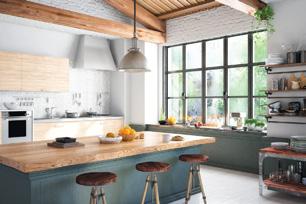
brighten up the space. Also, this is a neat trick: Reflective surfaces, such as glass, increase the amount of light in a room by bouncing around, so opt for glass tables or extra mirrors in your room to capture all of that glorious natural light. Most paints contain toxic fumes and chemicals, so try and opt for paint brands that are low or zero-VOC and that don’t harm the environment.

I love natural textiles in interiors, and they’re continuing to be a major theme in this season’s design ethos. Eco-friendly and naturally-sourced fabrics are all the rage and can be recycled, as can vintage woods, banana fibre, Afghan wools, hemp, seagrass, burlap, raw cotton or linen. Not only can they come in a variety of different textures, but they are also capable of being ethically sourced. Beyond materials for furniture or furnishings, organic materials can also be used in mattresses, upholstery or pillows. This can reduce the production of synthetic materials that sadly end up in our landfills.
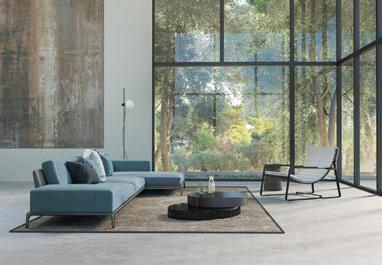
It is aesthetically so pleasing to have a home filled with greenery, and plants work double-duty in that they give oxygen and eliminate harmful substances from the air. Plants also provide a natural look and freshness in your home. NASA’s Clean Air Study found a number of air-purifying plants that can detoxify your home from the airborne toxins, dust and germs found in a variety of household products, materials and furniture. To make that level of difference to the air quality inside your home, you would need a significant number of house plants to work together to clean the air (in the ballpark of around 90). Yet, with houseplants becoming an interior design trend that looks like it’s here to stay, we might as well choose one that will go partway to improving the air we breathe, even if it’s not all of it. English ivy, snake and spider plants and chrysanthemum help filter out toxins, including ammonia and benzene found in varnishes, floor finishes and detergents.

I love vintage furniture, and when we are making more efforts to be more mindful of the planet, we should really be aware of the furniture and decor pieces we choose. When we

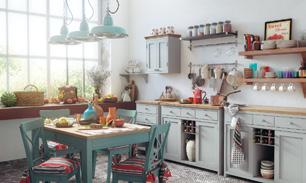

repurpose an old-found treasure, we immediately reduce waste, overproduction and our footprint – all good things. I know buying a brandnew piece can be exciting, but so can sourcing and hunting for that vintage piece full of legacy and sentimentality. Browse online marketplaces or go the old-fashioned route and head to some estate sales or vintage markets. I guarantee you will stumble upon some unique finds that will give your home a new look.
Lisa Rogers is Executive Vice-President of Design for Dunpar Homes (dunparhomes.com). Lisa has shared her style and design expertise on popular television programs such as Canadian Living TV, House & Home TV and as a regular guest expert for fashion and image, health and wellness and design on CityTV’s Cityline. Follow Lisa’s blog at craftedbylisa.ca




 by LINDA MAZUR
by LINDA MAZUR
Spring is here, and with it comes the traditional release of all new and wonderful fabrics bursting with vibrant colours, patterns and textures. As a designer, I look forward to the start of a new project. I enjoy pouring over fabric books gathering ideas and direction and have been known to design an entire space just from the inspiration of one fabric.
Fabric is tactile, and the feel of lush soft velvets, the beauty of some richly woven silks and the simplicity and texture of coarsely woven linen accompanied by rich, saturated colours is enough to inspire anyone to decorate. The question, however, is with all of these fabrics and patterns to select from how do you know what works together to achieve that “designer look” in your home.
Blending all different fabrics together is not as difficult as you may think, but there are a few key points to remember. To successfully mix fabric patterns like a pro a good place to start would be with something simple like blending a minimum of three fabric patterns. The first pattern selection should be your most impactful one therefore, choose carefully and select a pattern you love that is larger scale.
The second pattern should be completely different, probably about half the scale of the first one and have some of the same colours incorporated throughout.
For the third selection, it can be smaller scale and similar in pattern to either of the first two, with at least two to three of the colours found in the other patterns. So, for example, if you have selected a large-scale
floral as your first pattern, the second could perhaps be a bold stripe or a geometric fretwork pattern, and then blend in another small-scale alternate geometric.

Consider adding another pattern or two, or three, if you wish; maybe a small check, a dot pattern is always favourable, or perhaps repeat with another stripe or floral. If you’re more adventurous, consider throwing an animal print into the mix for a bit of fun.
Balancing textures and fabric weight is also important to achieve a well-blended mix of fabrics, as is maintaining the same depth or magnitude of colour. By that, I mean if you’re working with primary colours, then try not to incorporate fabrics that are pastels, as you will inevitably create an imbalance.
When combining and layering patterns, it is important to balance the patterns throughout your space, the last thing you’ll want to do is create a situation where the heavier weight of patterns and colours are all at one end of the room. They should be well proportioned
with solids and any other visible patterns in your room, such as area rugs, wall coverings, fireplace surrounds to provide equilibrium and an aesthetically pleasing look. In addition, it’s important when pairing up your choices to consider the “feel” of the fabrics you’re selecting – for example, whether they are formal or more casual – and then maintain consistency.

Pattern blending can be fun, and these fabrics can create a bold statement in your home. Mixing fabrics like a pro is all about balance, layering and blending. When it’s done well, contrasting but complementary patterns and textures can elevate your space beyond the typical to a fresh, innovative and welcoming home. Toiles, stripes, florals, ikats and check are just some of the many different patterns we see, blend them with rich velvets, textural boucle, linens or silks to give your home that designer touch.

Just remember to keep a common element, and work with your scales and colours to see your home come alive.
Linda Mazur is an award-winning, nationally publicized designer and Principal of Linda Mazur Design Group. With almost two decades of experience this in demand multi-disciplinary design firm is known for creating relaxed, stylish spaces and full-scale design builds within Toronto, the GTA and throughout Canada. lindamazurdesign.com
@LindaMazurGroup

When the Ontario government introduced Bill 97, the Helping Homebuyers, Protecting Tenants Act, earlier this month, it continued to honour the pledge it had made as part of its Housing Supply Action Plan to have annual housing legislation aimed at addressing housing supply and affordability in the province. At the same time, the government announced a consultation on changes to the provincial policy statement (PPS), the document that governs land use planning in Ontario. Bill 97 and the PPS consultation are significant steps toward addressing the very complex problem of housing supply and affordability.

As I often point out, the housing challenges in our province and region are the results of misguided policy decisions made by past governments, and can only be addressed through policy that enables – rather than hinders – the building of new housing. The recently announced consultation proposes to combine the PPS and another policy document that governs how and where housing will be built – the Growth Plan for the Greater Golden Horseshoe – into a single document that prioritizes housing. If adopted, this change will represent a significant shift in planning policy that will simplify the addition of new housing.
Bill 97 includes two measures that would facilitate the addition of housing supply. The first is a

proposal to make it easier to convert land zoned for employment uses to residential uses, while protecting true employment spaces through a new, modern definition of employment. The other is a proposal to provide greater flexibility for municipalities to expand their boundaries to accommodate future growth. As housing supply and affordability are contingent on land supply, this change would help deliver muchneeded housing.
As its name implies, the legislation also includes new protections for tenants and new-home buyers. The first proposal seeks to protect tenants against abuse and evictions – vital in a time of tight rental supply and rising rents – while recognizing that property owners must be able to maintain and renovate their properties. The second proposal introduces a cooling-off period on purchases of newly built freehold homes. Our industry looks forward to
participating in the consultations on this proposal.
With the introduction of Bill 97 –the provincial government’s fourth housing bill under the Housing Supply Action Plan – and the announcement of the PPS consultation, the government should be applauded for continuing to take positive steps to address housing supply, bring affordability back to the province and enable more Ontarians to buy the homes they need.
